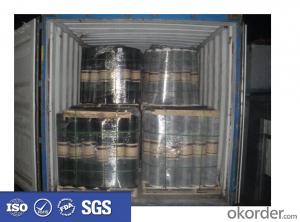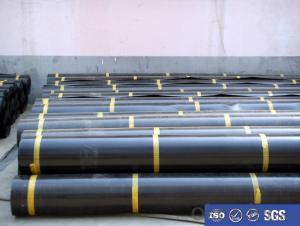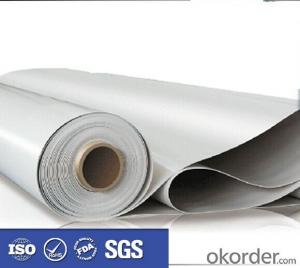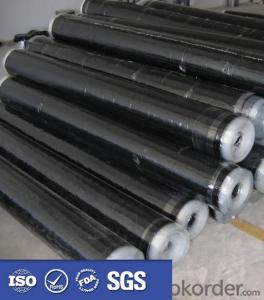EPDM Waterproofing Rubber Roofing Membrane New Kind
- Loading Port:
- Qingdao
- Payment Terms:
- TT OR LC
- Min Order Qty:
- 2000 m²
- Supply Capability:
- 8000000 m²/month
OKorder Service Pledge
OKorder Financial Service
You Might Also Like
Description Of EPDM Waterproofing Rubber Roofing Membrane New Kind:
Self adhesive waterproof rolling material:
thickness:1.2/1.5/2.0mm
length/roll:10/20m
width/roll:1.02m
Low temperature:-15 -20,-30
Main Features of EPDM Waterproofing Rubber Roofing Membrane New Kind:
1) High tear
2) High puncturing strength
3) Great temperature resistance.
4) High dimensional stability
Specifications of EPDM Waterproofing Rubber Roofing Membrane New Kind:
Material | EPDM Self-adhesive Waterproof Membrane |
Size | 1.2m (width)*20m (length) or customized, weldable type 2.05m or 4m width |
Thick | 1.2mm, 1.5mm, 2.0mm |
Type | Vulcanized & Weldable |
Pattern | Non-reinforced (homogeneous) |
Certificate | ISO9001/14001 |
Applications of EPDM Waterproofing Rubber Roofing Membrane New Kind:
1.It is widely used in civil and industry construction.
2.The waterproof,dampproof of the roofs,basements,toilets etc;
3.And the waterproofing of subway,underground,bridges,car parking,tunnels,reserviors,pool etc.
4.SBS modified bitumen waterproof membrane is specially suitable to the building waterproofing in cold area and to the buildings of changeable constructions
5.APP specially suitable to areas of high temperature and of strong sunshine.
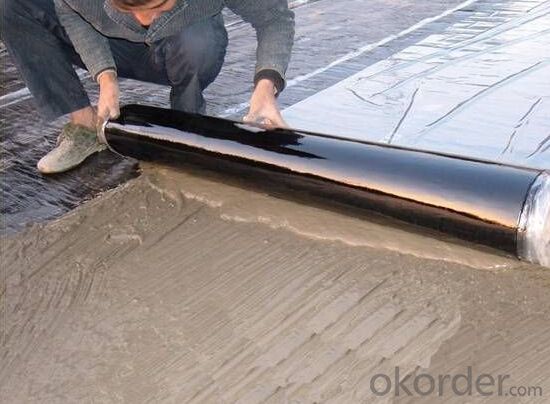


FAQ:
1. What are we supplying?
We are specialized in producing Colorful Asphalt Roof Shingle, SBS/APP modified bitumen waterproof membrane, Self adhesive bitumen waterproof membrane, PVC waterproofing membrane, EPDM rubber roofing membrane, Single Component Polyurethane Waterproof Coating, and Spray Polyurea Waterproof Coating.
2. How Many years experience do we have?
We have been exported to more than 20 countries in the past 15 years.
3. How long do we usually reply your request?
We always reply our customer within 24 hours.
- Q:Can a waterproofing membrane be used for residential buildings or homes?
- Yes, a waterproofing membrane can be used for residential buildings or homes. Waterproofing membranes are commonly used in construction to prevent water penetration and protect the building's structure and interior from moisture damage. They can be applied to various areas such as basements, roofs, foundations, and bathrooms, among others. By creating a barrier against water, these membranes help to prevent leaks, mold growth, and damage to the building materials. Therefore, using a waterproofing membrane is an effective way to ensure the longevity and durability of residential buildings or homes.
- Q:Basement SBS Waterproof Coil Division I and II type What is the difference? How is the site identified?
- Type I low temperature flexibility is -20 degrees, pulling force of 500N / 5cm, elongation of 30%. Type II low temperature is -25 degrees, tension of 800N / 5cm, elongation of 40%. The appearance of the general can not distinguish, you can take the sample to the laboratory to be a tensile test on it.
- Q:Is a waterproofing membrane resistant to hydrocarbons or oil spills?
- Yes, a waterproofing membrane is generally resistant to hydrocarbons or oil spills.
- Q:Can a waterproofing membrane be used for medical facilities?
- Yes, a waterproofing membrane can be used for medical facilities. Waterproofing membranes are commonly used in construction to protect buildings from water damage and leaks. In medical facilities, it is important to maintain a clean and hygienic environment, and preventing water infiltration and moisture buildup is crucial for this purpose. Waterproofing membranes can be applied to various surfaces including floors, walls, and roofs, to create a barrier against water penetration. This helps to prevent the growth of mold, mildew, and bacteria, which can be harmful to patients and staff. Additionally, waterproofing membranes can also provide protection against chemical spills and contamination, further enhancing the safety and cleanliness of medical facilities.
- Q:Can a waterproofing membrane be used in conjunction with energy-efficient building designs?
- Yes, a waterproofing membrane can be used in conjunction with energy-efficient building designs. In fact, it is often recommended to have a waterproofing membrane as part of energy-efficient building designs, as it helps to protect the building from moisture infiltration and potential damage. By preventing water penetration, the membrane helps maintain the integrity of the building envelope, thus optimizing the energy performance and overall efficiency of the structure.
- Q:Can a waterproofing membrane be used in permanent or long-term structures?
- Certainly, permanent or long-term structures can indeed make use of a waterproofing membrane. By creating a protective barrier against water infiltration, waterproofing membranes are perfectly suited for structures requiring extended safeguarding against moisture, such as buildings, bridges, tunnels, and underground constructions. These membranes are typically crafted from resilient materials like modified bitumen, PVC, EPDM, or polyurethane, which boast exceptional resistance to water, UV rays, and other environmental elements. A properly installed waterproofing membrane can significantly prolong the lifespan of a structure by thwarting water damage, mold growth, and structural decay. It is therefore highly advisable to utilize a waterproofing membrane in permanent or long-term structures to ensure their robustness and longevity.
- Q:How does a waterproofing membrane perform in areas with chemical exposure or solvents?
- A waterproofing membrane is designed to provide protection against water penetration, but it may not be effective against chemical exposure or solvents. Chemicals can potentially degrade or damage the membrane, compromising its waterproofing capabilities. It is important to select a membrane specifically designed for chemical resistance if the area is expected to have chemical exposure or solvents.
- Q:Are waterproofing membranes resistant to hydrocarbons?
- Yes, waterproofing membranes are generally resistant to hydrocarbons. Waterproofing membranes are designed to provide a barrier against water penetration and are often made from materials such as bitumen, PVC, TPO, or EPDM. These materials have inherent resistance to hydrocarbons and can withstand exposure to various types of hydrocarbon-based substances such as oil, gasoline, diesel, and other petroleum-based products. This resistance ensures that the waterproofing membrane remains intact and effective in preventing water infiltration even when exposed to hydrocarbons. However, it is important to note that the specific resistance of a waterproofing membrane to hydrocarbons may vary depending on the material used and its quality. Therefore, it is always recommended to consult the manufacturer's specifications and guidelines to ensure the appropriate selection and installation of a waterproofing membrane for specific hydrocarbon-resistant requirements.
- Q:Can a waterproofing membrane be used on different types of surfaces, such as concrete, wood, or metal?
- Yes, a waterproofing membrane can be used on different types of surfaces including concrete, wood, and metal. Waterproofing membranes are designed to provide a protective barrier against moisture and can adhere to various surfaces, ensuring effective waterproofing regardless of the material.
- Q:Can a waterproofing membrane be applied in cold weather or during winter months?
- Yes, a waterproofing membrane can be applied in cold weather or during winter months. However, there are specific considerations and precautions that need to be taken into account. It is important to choose a waterproofing membrane that is specifically designed for cold weather applications. These membranes are formulated to withstand low temperatures and provide effective waterproofing even in freezing conditions. Before applying the membrane, the surface should be thoroughly cleaned and free from any debris, ice, or snow. It is also crucial to ensure that the surface is dry, as moisture can affect the adhesion and performance of the membrane. In cold weather, it may take longer for the surface to dry, so extra time should be allowed for this process. Additionally, the ambient temperature during the application should be within the recommended range specified by the manufacturer. Cold temperatures can affect the curing time of the membrane and may require longer curing periods. It is important to follow the manufacturer's instructions and guidelines for application and curing to ensure proper performance. Moreover, it is advisable to consult with a professional waterproofing contractor who has experience working in cold weather conditions. They can provide expert guidance and ensure that the membrane is applied correctly to achieve the desired waterproofing results. Overall, while it is possible to apply a waterproofing membrane in cold weather or during winter months, it is crucial to choose the right product, prepare the surface properly, and follow the manufacturer's instructions and guidelines to ensure a successful and effective application.
1. Manufacturer Overview |
|
|---|---|
| Location | |
| Year Established | |
| Annual Output Value | |
| Main Markets | |
| Company Certifications | |
2. Manufacturer Certificates |
|
|---|---|
| a) Certification Name | |
| Range | |
| Reference | |
| Validity Period | |
3. Manufacturer Capability |
|
|---|---|
| a)Trade Capacity | |
| Nearest Port | |
| Export Percentage | |
| No.of Employees in Trade Department | |
| Language Spoken: | |
| b)Factory Information | |
| Factory Size: | |
| No. of Production Lines | |
| Contract Manufacturing | |
| Product Price Range | |
Send your message to us
EPDM Waterproofing Rubber Roofing Membrane New Kind
- Loading Port:
- Qingdao
- Payment Terms:
- TT OR LC
- Min Order Qty:
- 2000 m²
- Supply Capability:
- 8000000 m²/month
OKorder Service Pledge
OKorder Financial Service
Similar products
New products
Hot products
Related keywords
